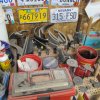Odie
Panning for Montana gold, with Betsy, the mule!
It looks like I may have discovered the reason why my bowls had a reddish cast to them in my photos.
I was shocked to see the difference in coloring of this Madrone burl bowl. The two photos were taken one after the other.....the only difference is the greenish rug was replaced with a white blanket for backdrop. No changes in camera settings, lighting, and no software adjustments of any kind......straight from the camera to your eyes.
I've been pretty stubborn about changing the green rug, because I've really liked the textured look to it.......now, I'll try to get something else, but in white, if this looks good to those on this forum.
OK......admittedly, I'm such a dummy with the camera, but there was nothing in the instructions that covered this aspect.......
What do you think? White backdrop look good to go?
I am aware that lighting still needs to be adjusted......have been experimenting with draping cloth over the bulbs, and positioning. I know I need to do something about the "hot spots", and I'm still working on that..........
thanks
ooc
I was shocked to see the difference in coloring of this Madrone burl bowl. The two photos were taken one after the other.....the only difference is the greenish rug was replaced with a white blanket for backdrop. No changes in camera settings, lighting, and no software adjustments of any kind......straight from the camera to your eyes.
I've been pretty stubborn about changing the green rug, because I've really liked the textured look to it.......now, I'll try to get something else, but in white, if this looks good to those on this forum.
OK......admittedly, I'm such a dummy with the camera, but there was nothing in the instructions that covered this aspect.......
What do you think? White backdrop look good to go?
I am aware that lighting still needs to be adjusted......have been experimenting with draping cloth over the bulbs, and positioning. I know I need to do something about the "hot spots", and I'm still working on that..........
thanks
ooc












